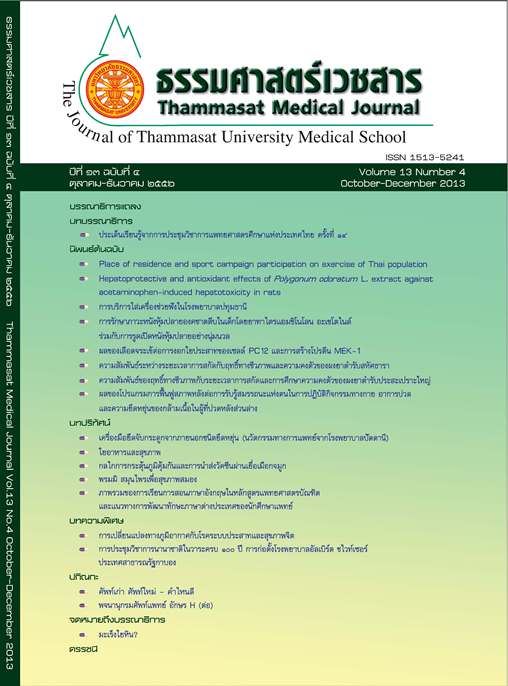Correlation of biological activities on different extraction period times and stability study of Pra-sa-prao-hyai remedy
Keywords:
Pra-sa-prao-hyai, Antiallergy, DPPH scavenging activities, Total phenolic contentAbstract
Introduction: Pra-sa-prao-hyai formula has been used in Thai traditional medicine to treat colds, asthma and fever and it isalso a herbal preparation in herbal national drug list in Anno Domini 2011. There is no report for biologicalcontrol of this preparation. Thus, the objective of this research was to study on correlation of biologicalactivity of extract from Pra-sa-prao-hyai remedy and extraction period times. This knowledge was alsoused to investigate for stability of powder drug of this remedy.
Methods: Pra-sa-prao-hyai remedy was extracted with 95% ethanol in different times, they were 1, 3, 5, 7, 9and 11 days respectively. All of extracts were tested for antiallergic activity by determination on inhibitoryeffect of β-hexosaminidase enzyme from Rat basophilic leukemia (RBL-2H3). DPPH scavenging activitywas also tested by DPPH radical assay and total phenolic content was measured by Folin-Ciocalteu reagent.The day of extraction which showed the highest of allergic activity was also used for studying on stabilityof Pra- sa-prao-hyai powder drug. The stability studies by an accelerated condition (45oC and 75% RH)of crude remedy were studied by keeping in 6 different times (Day 0, 15, 30, 60, 90 and 120 respectively).Then, these powder drugs which was kept in each times was extracted and tested antiallergic activity.
Results: The extracts from crude drug which were extracted in each times were not significantly different onantiallergic and total phenolic content (p > 0.05). The DPPH scavenging activity of extract at Day 3, 7 and11 were significantly different with Day 1. The extract at Day 1 showed the best antiallergic activity(IC50 = 12.83 ± 0.84 μg/ml), total phenolic contents 28.43 ± 3.67 mg gallic acid/g extract and it showedthe fifth of DPPH scavenging activity (EC50 = 85.84 ± 4.18 μg/ml). It showed reversely correlationbetween antiallergic and DPPH scavenging activities (p < 0.05, r = -0.871). The crude powder of Pra-saprao-hyai remedy was stable because the percentage of antiallergic activity of each time was notsignificantly different when they were compared with Day 0 (p > 0.05).
Discussion and Conclusion: The best time for extraction of Pra-sa-prao-hyai remedy was maceration for one day. Pra-sa-prao-hyaiand remedy powder was stable and it had shelf life of antiallergic activity as 2 years.
Key words: Pra-sa-prao-hyai, Antiallergy, DPPH scavenging activities, Total phenolic content



